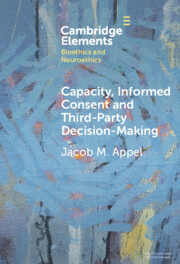159 results
Turning Our Backs: Epistemic Reasons for Disengaging From Academics Due to Moral Transgressions?
-
- Journal:
- Episteme , First View
- Published online by Cambridge University Press:
- 28 March 2025, pp. 1-20
-
- Article
-
- You have access
- Open access
- HTML
- Export citation
Generative AI systems in legal practice offering quality legal services while upholding legal ethics
-
- Journal:
- International Journal of Law in Context , First View
- Published online by Cambridge University Press:
- 27 March 2025, pp. 1-22
-
- Article
-
- You have access
- Open access
- HTML
- Export citation
2 - Definition of the Girl Child
-
- Book:
- The Status of the Girl Child under International Law
- Published online:
- 06 March 2025
- Print publication:
- 13 March 2025, pp 47-76
-
- Chapter
- Export citation
Chapter 3 - Safety and Ethics in Technological Participatory Health Research with Adolescents
-
- Book:
- Technological Innovations in Participatory Health Research with Adolescents
- Published online:
- 20 February 2025
- Print publication:
- 27 February 2025, pp 60-86
-
- Chapter
- Export citation
9 - Moral Categorization and Mind Perception
- from Part II - Thinking and Feeling
-
-
- Book:
- The Cambridge Handbook of Moral Psychology
- Published online:
- 20 February 2025
- Print publication:
- 27 February 2025, pp 198-221
-
- Chapter
- Export citation
Chapter 4 - The Law and Paediatric Anaesthesia
-
-
- Book:
- Core Topics in Paediatric Anaesthesia
- Published online:
- 06 February 2025
- Print publication:
- 13 February 2025, pp 35-41
-
- Chapter
- Export citation
5 - Conclusion and Further Exercises
-
- Book:
- Improving Your British Sign Language
- Published online:
- 02 January 2025
- Print publication:
- 16 January 2025, pp 196-220
-
- Chapter
- Export citation
Practitioner competence and clinical outcomes during cognitive behavioural and cognitive-analytic guided self-help for anxiety
- Part of
-
- Journal:
- The Cognitive Behaviour Therapist / Volume 17 / 2024
- Published online by Cambridge University Press:
- 04 December 2024, e40
-
- Article
-
- You have access
- HTML
- Export citation
12 - Language and Cognition in Conversations with a Person with Alzheimer’s Disease
- from Part 5 - Communicative Challenges in Everyday Social Life
-
-
- Book:
- Dementia and Language
- Published online:
- 21 November 2024
- Print publication:
- 28 November 2024, pp 269-291
-
- Chapter
- Export citation
Nurses’ models of spiritual care: Predictors of spiritual care competence
-
- Journal:
- Palliative & Supportive Care , First View
- Published online by Cambridge University Press:
- 13 November 2024, pp. 1-8
-
- Article
-
- You have access
- Open access
- HTML
- Export citation
A constitutional perspective on EU arms controls: mediating trade, security, and humanitarian responsibility
-
- Journal:
- European Law Open / Volume 3 / Issue 2 / June 2024
- Published online by Cambridge University Press:
- 18 October 2024, pp. 312-335
-
- Article
-
- You have access
- Open access
- HTML
- Export citation
Too Crooked to be Good? Trade-offs in the Electoral Punishment of Malfeasance and Corruption
-
- Journal:
- European Political Science Review / Volume 17 / Issue 1 / February 2025
- Published online by Cambridge University Press:
- 12 September 2024, pp. 61-79
-
- Article
-
- You have access
- Open access
- HTML
- Export citation

Capacity, Informed Consent and Third-Party Decision-Making
-
- Published online:
- 03 June 2024
- Print publication:
- 17 October 2024
-
- Element
- Export citation
The best at the top? Candidate ranking strategies under closed list proportional representation
-
- Journal:
- Political Science Research and Methods / Volume 12 / Issue 4 / October 2024
- Published online by Cambridge University Press:
- 22 April 2024, pp. 706-728
-
- Article
-
- You have access
- Open access
- HTML
- Export citation
Chapter 53 - Quality Control and Laboratory Accreditation
- from Section 4 - Laboratory Diagnosis
-
- Book:
- Clinical and Diagnostic Virology
- Published online:
- 11 April 2024
- Print publication:
- 18 April 2024, pp 258-262
-
- Chapter
- Export citation
Conceptual competence in psychiatric training: building a culture of conceptual inquiry
-
- Journal:
- BJPsych Bulletin , FirstView
- Published online by Cambridge University Press:
- 02 April 2024, pp. 1-6
-
- Article
-
- You have access
- Open access
- HTML
- Export citation
THE DICHOTOMY BETWEEN JURISDICTION AND ADMISSIBILITY IN INTERNATIONAL ARBITRATION
-
- Journal:
- International & Comparative Law Quarterly / Volume 73 / Issue 2 / April 2024
- Published online by Cambridge University Press:
- 12 April 2024, pp. 417-446
- Print publication:
- April 2024
-
- Article
-
- You have access
- Open access
- HTML
- Export citation
9 - Adolescent Autonomy
-
- Book:
- Fortin's Children's Rights and the Developing Law
- Published online:
- 08 February 2024
- Print publication:
- 29 February 2024, pp 339-371
-
- Chapter
- Export citation
Higher-order CBT skills: are there differences in meta-competence between trainee and experienced therapists?
-
- Journal:
- The Cognitive Behaviour Therapist / Volume 17 / 2024
- Published online by Cambridge University Press:
- 22 February 2024, e7
-
- Article
-
- You have access
- Open access
- HTML
- Export citation
Identifying core global mental health professional competencies: A multi-sectoral perspective
-
- Journal:
- Cambridge Prisms: Global Mental Health / Volume 11 / 2024
- Published online by Cambridge University Press:
- 22 February 2024, e24
-
- Article
-
- You have access
- Open access
- HTML
- Export citation


